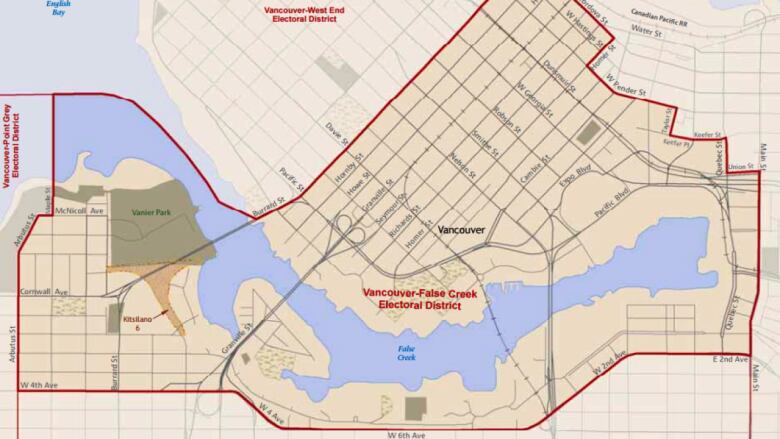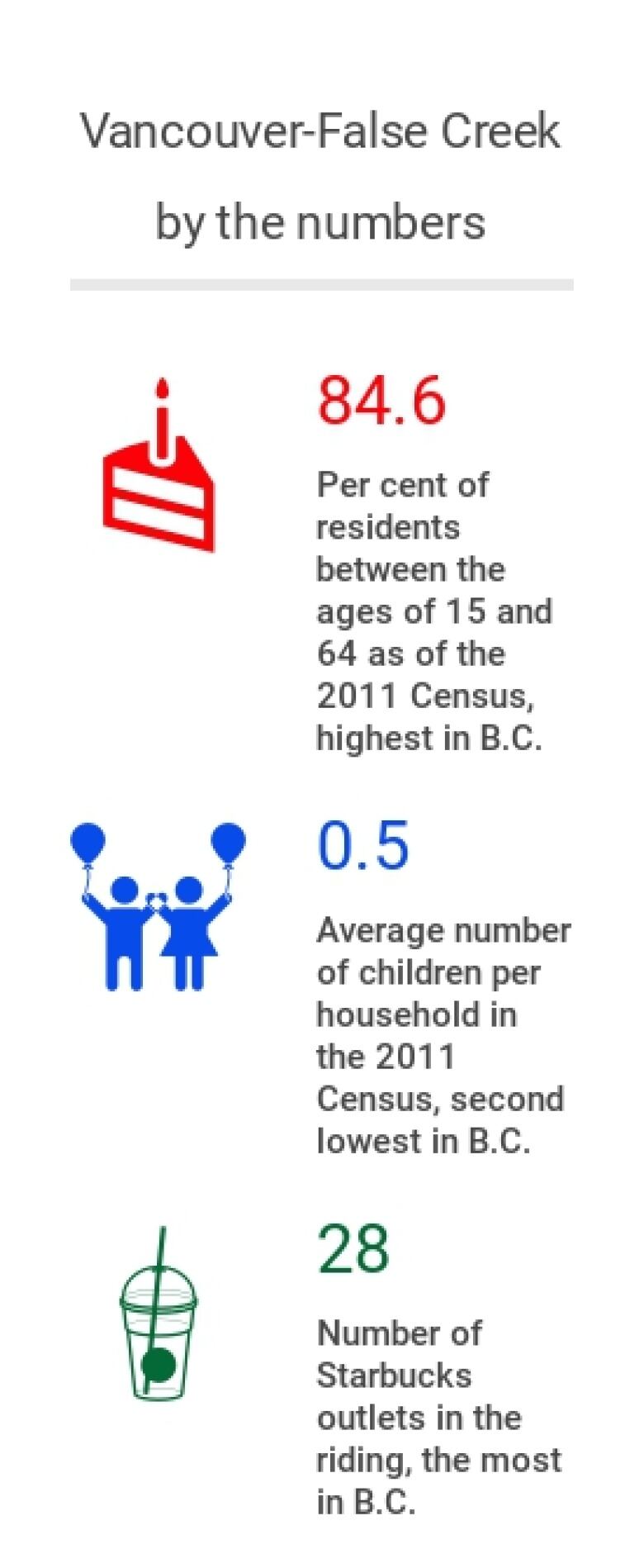B.C. Votes 2017: Vancouver-False Creek riding profile
Former Vancouver mayor Sam Sullivan seeks a 2nd term in one of downtown Vancouver's 2 ridings

In advance of the 2017 B.C. election, we'll be profilingall 87 electoraldistrictsin the province. Here is Vancouver-False Creek, one of 11 ridings in Vancouver and despite its small size, one of the harder ridings in B.C. to campaign in.
1. Vancouver-False Creek is many things diverse, fast-growing, condo-filled, Starbucks-heavy, teeming with young professionals, bereft of children and seniors andit may also be the only place where dog biscuits can be a strategic tool.
"I try and get access to lobbiesof buildingand one of the most important functions is the biscuit laying," said B.C. Liberal MLA Sam Sullivan, who is seeking re-election in a riding full of condosbuilt over the last 20 years, where lobbiesare the only place public access is allowed.
"A lot of people in these buildings have dogs, and they tend to take them out for walks. That's the one time I can really interact with them. By having a dog biscuit near me, I can get the attention of their dog, and the path to a voter's heart is through their dog."
2. This isn't Sullivan's first rodeo.
He's won all six elections he's ran in: four for Vancouver city council from 1993 to 2002, one for Vancouver mayor in 2005 (losing the NPA nomination to Peter Ladner in 2008)and his 2013 victory here.

During that time, Vancouver has grown into an international city, and much ofthat transformation has been based on what's happened toVancouver-False Creek: while the south False creek neighbourhood and east Kitsilano are a well-estabslihed areas with a mix of social and affordable housing, Yaletown, Crosstown and the Olympic Village are all relatively new, predominately for-profit apartment units, and planning is underway for the east False Creek neighbourhood and demolition of the viaducts.
"Being able to experience Expo 86, and after that the rezoning, and then the complete transformation of False Creek into a gem of people and recreation,this is nothing short of miraculous," said Sullivan.
"It's exciting to see people come from other parts of the world to see how we did it. Many cities do see us as the future, and they come to see what's in store for them. It's truly wonderful to be able to watch the growth."
3. But that growth has caused strains on infrastructure.
"Certainly with the growth, we're finding a lot of problems and challenges with the availability of daycare, and schools, and it often takes the government a bit of lagtime to catch up with the demographics," admittedSullivan.
It means more young families or people hoping to have children soon are worried where their children will go to school, an issue NDP candidate Morgane Oger says she'll be making a big part of her campaign.
"We don't have a secondary school in our riding.We're dependent on other ones, which are very, very small," she said.
"Especially in Yaletown, people move in and give up their car because locally it isn't set up for cars, and it turns out they were wrong. Parents can't get their kids into a local kindergarten, all of the adjacent ones are filled.They have to go two schools away, and it's not feasible without a car."
4. The NDP haslost this riding by over 3,500 votes in both elections in which it's been been contested, but Oger is confident.
For one, the riding has lost Coal Harbour to Vancouver-West End, eliminating an area where the NDP waslucky to break 30 per cent support. For another, the NDP leaptfrom 27 per cent in 2009 to 37 per cent in 2013.
And Oger believes her story a high-profile activist, professional in the high-tech and financial sectors, and the first transgender woman to be nominated by a major political party in Canada is one that will appeal to voters.
"People respect what I've done in education and activism.They respect my commercial and technology and energy background, my work on large corporations and with banks is valued as credible and important," she said.
"I'm coming in with quite a bit of press exposure andawareness."
The Green Party candidate is Bradley Shende, the founder of a digital creative agency and BCIT instructor.
5. Where does the NDP do well?
The old mixed-use False Creek neighbourhoods between Granville and Cambie consistently support the NDP, giving the partybetween 45 to 70 per cent support depending on the exact area.
6. What about the Liberals?
They're strong everywhere downtownbut particularly the areas in south Yaletown surrounding David Lam park, which gave Sullivan over 70 per cent support across three polling stations last election. The Liberals also did extremely well in Coal Harbour, but that area was transferred over to Vancouver-West End in the redistribution that goes into effect this election.
7. It stands to be a hard-fought, high-profile campaign in the centre of Vancouver, even though the style of campaigning isn't the most traditional.
"The riding is probably the most accessible in the country but people don't often listen to radio, because the radiowaves don't go through the concrete," said Sullivan. "They don't get newspapers, because nobody can get a newspaper to their door. It's almost impossible to get to a door, so you can't do door-knocking. The party provides me all of these lawn signsand I don't even have lawns.
"It's very challenging, but on the positive side, it's challenging for my opponents too. It's an even playing field."












_(720p).jpg)


 OFFICIAL HD MUSIC VIDEO.jpg)
.jpg)



























































































